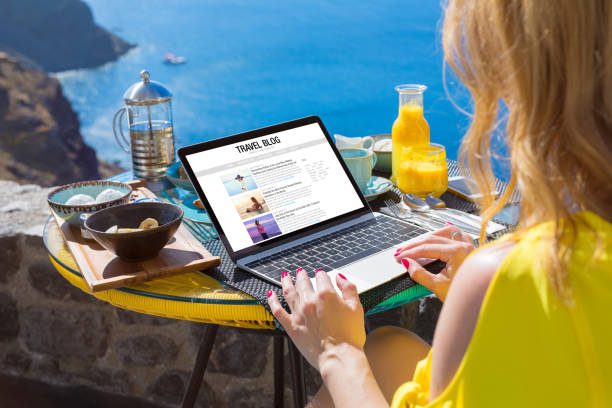
So, you want to start a travel blog but feel overwhelmed? Maybe you think it’s too technical, or you’re not sure where to begin. I get it, I had those same doubts before I started. Starting a profitable blog is not hard.
But here’s the truth: starting a travel blog is easier than you think. You don’t need coding skills, web design experience, or any advanced tech knowledge. If you can navigate Instagram, Facebook, or Pinterest, you can run a blog.
Most of it comes down to writing posts, adding photos, and tweaking your layout, and anyone can learn that!
Think of it like learning a new social media platform. At first, it feels unfamiliar, but the more you use it, the easier it gets.
Blogging works the same way, step by step, you’ll build a fully functional travel blog that can eventually become a money-making brand.
Affiliate Disclosure: This post may include affiliate links with special discounts. Using them saves you money and supports our site at no extra cost to you. Win-win right! Check out our [Privacy Policy] for more details. Thanks for your support!
Summarized Steps Quick Set-Up Process
1️⃣ Pick Your Niche (e.g., “Luxury Travel Hacks,” “Budget Backpacking,” or “Family Vacation Tips”)
2️⃣ Get Hosting + Domain (Use HostGator – its perfect for beginners)
3️⃣ Install WordPress (Done in minutes through your HostGator account)
4️⃣ Publish Must-Read Content:
- “Packing List for [Destination]”
- “How to Travel [Country] on $50/Day”
- “[Airline] Flight Hacks Nobody Tells You”
5️⃣ Use Stunning Travel Photos (High-res images that inspire wanderlust)
Pro Tip: You don’t need to be tech-pro to start—setting up a blog is as easy as managing your Facebook or TikTok account. Plus, HostGator lets you try it risk-free with their 30-day money-back guarantee. If it’s not for you, just cancel and get a full refund—no hassle.
5 Proven Ways to Monetize
💰 Affiliate Commissions (Earn from Booking.com, Amazon Travel Gear, etc.)
💰 Display Ads (Google AdSense → Mediavine at 50k visitors)
💰 Sponsored Trips (Free stays + cash for hotel features)
💰 Travel Guides ($20 − $100 for digital downloads)
💰 Instagram/Youtube (Grow and monetize with brand deals)
Pro Tip: Focus on satisfying people’s intent with your post – “best times to visit…,” “hidden gems,” and money-saving tips perform best.
What You Need to Start a Travel Blog
Before hitting “publish,” make sure you have these essentials:
✅ A Computer – A laptop or desktop makes it easy to manage your blog, write posts, and keep everything updated.
✅ A Domain Name – This is your blog’s web address (e.g., yourtravelblog.com). Pick something memorable and travel-related.
✅ A Blogging Platform – WordPress.org is the best choice for beginners—it’s user-friendly and customizable.
✅ Web Hosting – Your blog needs a home on the internet. A reliable host like HostGator ensures fast performance, strong uptime, and hassle-free WordPress setup.
💡 Pro Tip: Once you sign up with HostGator, you can install WordPress in one click and start publishing immediately—no tech skills required!
How to Start a Travel Blog That Makes Money (9 Simple Steps)
This step-by-step guide will help you launch a profitable travel blog—even if you’re a complete beginner. I’ll show you how to set it up easily using HostGator, a top-rated web hosting service perfect for new bloggers.
- Step 1: Choose a Travel Sub-Niche
- Step 2: Click on HostGator To Get Started
- Step 3: Choose a Hosting Plan
- Step 4: Pick a Unique Domain Name
- Step 5: Adjust Your Hosting Subscription
- Step 6: Create Your HostGator Account
- Step 7: Install WordPress Inside Your HostGator
- Step 8: Choose a Blog Theme
- Step 9: Customizey Your site and Start Publishing
Step 1: Choose Your Travel Sub-Niche
Picking the right sub-niche is crucial for standing out in the crowded travel blogging space. By specializing, you’ll attract a more targeted audience and establish yourself as an authority. Here are 5 of the most profitable travel niches to consider, each with content ideas to spark your creativity:
1. Budget Travel
Perfect for helping cost-conscious travelers maximize their experiences. This niche focuses on money-saving tips, affordable destinations, and smart travel hacks.
• “How to Travel Southeast Asia for Under $30/Day”
• “10 Credit Card Hacks for Free Flights and Upgrades”
• “Best Times to Book Hotels for Maximum Savings”
2. Luxury Travel
Cater to affluent travelers seeking premium experiences, exclusive accommodations, and high-end adventures.
• “The Most Instagrammable 5-Star Resorts in the Maldives”
• “Private Island Rentals: Luxury That’s Surprisingly Affordable”
• “A Foodie’s Guide to Michelin-Starred Restaurants in Paris”
3. Solo Travel
Guide independent explorers with safety tips, destination guides, and advice for traveling alone confidently.
• “Safest European Cities for First-Time Solo Travelers”
• “How to Make Friends While Traveling Solo: A Complete Guide”
• “Essential Safety Apps Every Solo Traveler Should Have”
4. Adventure Travel
For thrill-seekers who want adrenaline-pumping activities and off-the-beaten-path experiences.
• “Hiking Active Volcanoes: Best Destinations for Beginners”
• “Swimming with Whale Sharks: Where and When to Go”
• “Multi-Day Trekking Routes That Will Change Your Life”
5. Digital Nomad Lifestyle
Help remote workers balance travel and work with practical tips on destinations, visas, and productivity.
• “Best Cities with Reliable WiFi Under $1,500/Month”
• “Step-by-Step Guide to Getting a Digital Nomad Visa in Portugal”
• “How to Build a Location-Independent Business While Traveling”
Key Consideration: Choose a niche that aligns with both your expertise and audience demand. Test your ideas by researching popular keywords and trends on Google and Pinterest before committing.
Step 2: Click On Our “HostGator” Discount Link
Once you’ve decided on which travel sub-niche to start, the next step is securing reliable web hosting. With our discounted HostGator hosting plan, you can launch your blog at a lower cost and even get a free domain name to match your travel brand.
For beginners, HostGator is a great choice because of its easy setup and affordable plans. However, if you prioritize premium specialties, other hosting like Siteground, WPX, and WP Engine are other reliable options you can also consider.
🚀 A well-hosted travel blog means faster load times and a better experience for your audience!
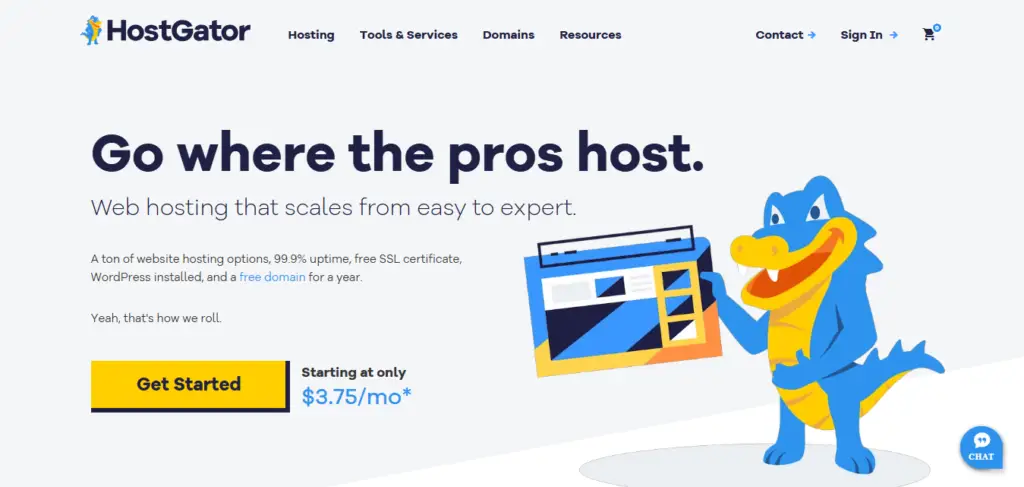
Step 3: “Choose Your Preferred HostGator Plan”
Selecting the HostGator hatchling plan is more advisable and cost-effective, after all, that’s the minimum plan, and you can always upgrade your plan anytime you want.
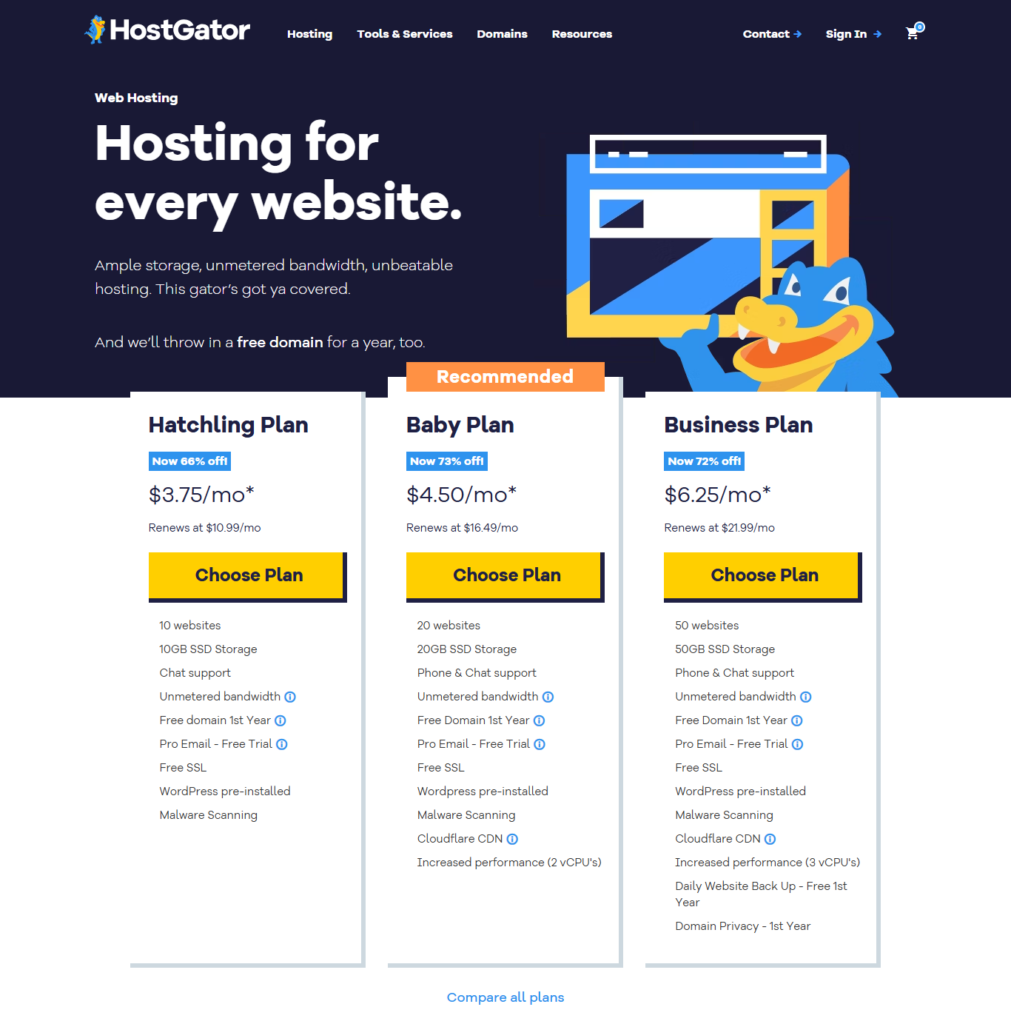
Step 4: Choose a Domain Name of Your Choice
Once you select your plan, you’ll be taken to a page where you can pick your domain and finish signing up.
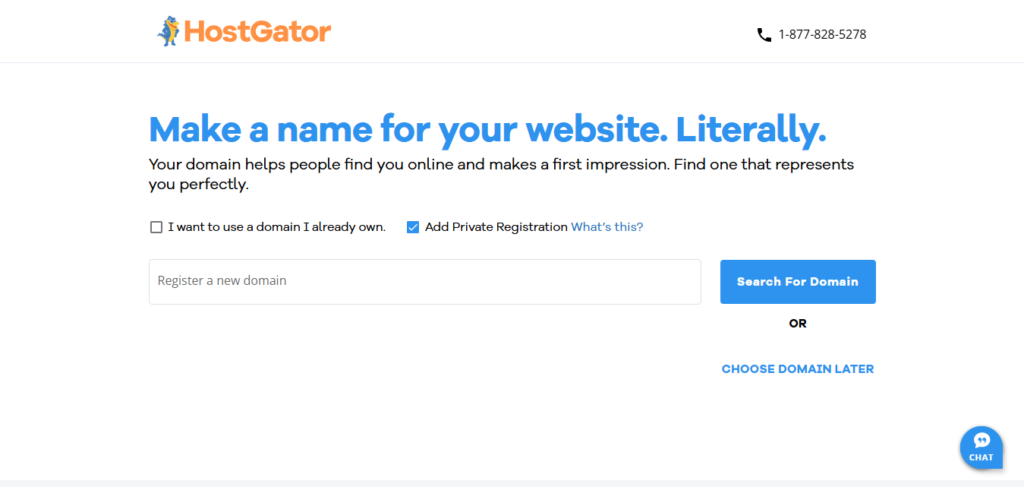
What to consider when choosing a travel blog domain name;
- Make it Adventurous & Easy to Remember – Choose a name that reflects wanderlust, like GlobeTrotterTales.com or NomadicVibes.com. Avoid hard-to-spell words.
- Reflect Your Niche – If you focus on budget travel, luxury travel, or solo travel, try including keywords like Backpacker, Luxury, or Solo (e.g., BudgetGlobetrotter.com).
- Keep it Short & Catchy – A short, catchy name like Wanderly.com is more memorable than TheUltimateBudgetTravelExperience.com.
- Easy to Read & Say – Avoid domain names that are tricky to spell or pronounce, such as XplrWrld.com. Clarity matters!
Find unique and meaningful travel-related blog name ideas
Step 5: Adjust to your preferred hosting subscription period
Confirm that you’ve selected the Hatchling plan on the left and adjust your subscription to either a 1-year or a 3-year option based on your affordability.
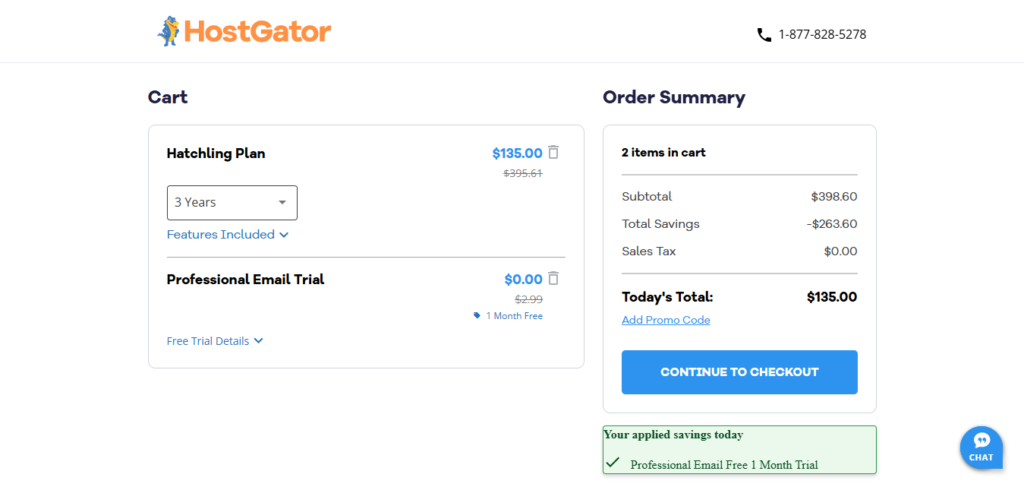
Step 6: Create Your HostGator account
Create your HostGator account by providing your email contact information and choosing a password.
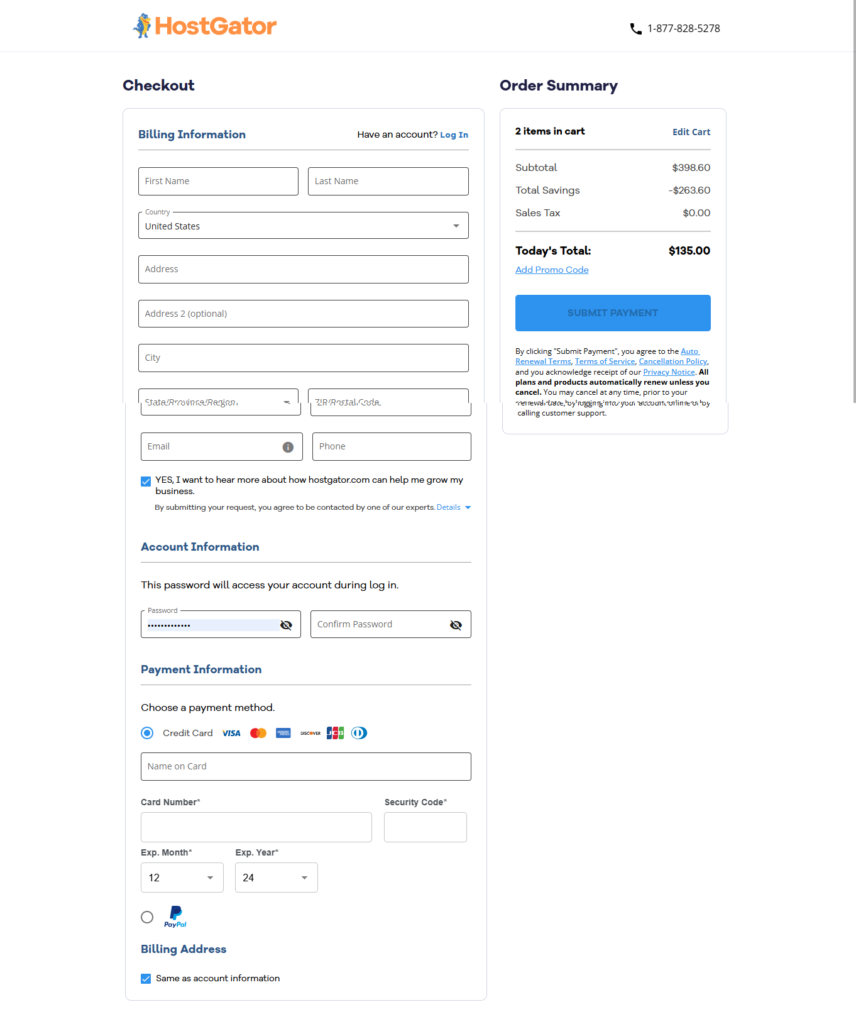
Preview your information before checkout.
Step 7: Install WordPress In Your HostGator Account
- After signing up with HostGator, follow the instructions on the screen to install WordPress.
- Or, log into your HostGator account and click on “Websites” or “WordPress”.
- Create your WordPress account, and you’ll be automatically logged in to start customizing your site and adding content.
Step 8: Pick the Perfect Theme for Your Travel Blog
Once you’re inside your WordPress dashboard, install and use a blog theme that makes it easy for you to get going. Instead of starting from scratch, you will be editing a pre-built site.
Here’s how to do it step by step:
Step 1: Go to Themes: WordPress Dashboard → Appearance → Themes
Step 2: Browse Options: Search for “travel” or filter by:
• Photo-friendly layouts
• Video support
• Mobile-responsive designs
Step 3: Preview & Check
- Test how it looks (click “Preview”)
- Read ratings/reviews
Step 4: Install & Customize: Free themes work great, but premium offers more features.
Pro Tip: Prioritize themes that highlight visuals – your travel photos are your best content!
Here are some of the best WordPress themes for travel blogs you can use.
Step 9: Personalize Your Travel Blog & Start Publishing Posts
Now comes the exciting part – making your travel blog reflect your unique wanderlust style! Here’s how to customize and launch like a pro:
1. Custoize Your Site Designs
- Choose vibrant colors that scream adventure (turquoise oceans, sunset oranges)
- Select easy-to-read fonts (perfect for long travel stories)
- Add a stunning header image of your favorite destination
- 2. Must-Have Pages for Travel Bloggers:
- About Page: “Why Follow My Travels” (share your story)
- Destinations Page: Interactive map of places you’ve visited
- Photo Gallery: Showcase your best travel moments
- Work With Me: For tourism board collaborations
3. Publish Your First Captivating Post
Start with these proven ideas:
- “My [Country] Adventure: 10 Unexpected Discoveries”
- “The Ultimate [City] 3-Day Itinerary”
- “How I Traveled [Destination] on $50/Day”
✈️ Pro Travel Blogger Tools:
- WP Travel (for itineraries)
- SmugMug (for stunning photo displays)
- Google Maps Embed (show your routes)
You’re Ready for Takeoff! Your blog can now:
- Attract fellow travelers (through Google searches)
- Land-sponsored trips (as you grow your audience)
- Earn through affiliate links (travel gear, booking sites)
First Week Flight Plan:
- Publish 3 diverse posts (1 personal story, 1 guide, 1 tips list)
- Create a Pinterest account and pin each post
- Join 3 travel blogger Facebook groups
Find Travel Blog Topic Ideas to Write & Publish
Now that your travel blog is live on the internet, you can use these methods below to find some great blog topic ideas to write about before monetizing those posts.
Here’s how to discover irresistible topics and craft posts people bookmark.
1. Mine These Travel Trend Sources
✅ Google Trends – Compare “Bali digital nomad” vs “Portugal digital nomad”
✅ Pinterest Predicts – Next big destinations (think: “Albania beaches 2024”)
✅ TikTok Travel Hashtags – #SoloFemaleTravel #VanLifeProblems
✅ Airbnb’s “Wishlisted” – See which unusual stays are going viral
Pro Tool: Use AnswerThePublic (free blog idea generator) for questions like “Is ____ safe for solo travelers?”
2. Evergreen Travel Content That Always Performs
These staples drive consistent traffic:
- Destination Guides – “3 Days in Bangkok: Ultimate Itinerary”
- Budget Breakdowns – “Costa Rica Trip Cost for 2 Weeks”
- Packing Lists – “Carry-On Only Packing List for Iceland”
- Photo Essays – “24 Hours in Tokyo in Photos”
- Comparison Posts – “Bali vs. Thailand: Which is Better for Digital Nomads?”
SEO Tip: Plug destinations into Google Keyword Planner (a free blog keyword research tool) to find low-competition terms.
3. Steal Real Questions From Travelers
Check platforms like:
🗣 Reddit – r/travel, r/solotravel (“What’s the most overrated destination?”)
💬 Facebook Groups – “Female Travel Bloggers”
📝 Quora – “Is ____ worth visiting in rainy season?”
Turn Them Into Posts: “The Truth About Santorini in Winter (From Someone Who Lived There)”
4. Repurpose With Fresh Angles
Update old posts with:
- 2025 data (“Mexico City Safety Update”)
- Video versions (“My Lisbon Itinerary – Now With Map Embed!”)
- Opposing views (“Why I Disagree With ____ Travel Advice”)
Must-Have Tool: SurferSEO (best AI content writing tool for optimizing old posts).
5. Content Types That Convert
| Post Type | Example | Best For |
|---|---|---|
| Listicles | “7 Hidden Beaches in Croatia” | Pinterest traffic |
| How-To Guides | “How to Travel Japan With Dietary Restrictions” | Google featured snippets |
| Personal Stories | “How I Got Scammed in Marrakech” | Social shares |
Formatting Tip: Use Clearscope (best content writing tool) to structure posts for readability.
6. Build Your Editorial Calendar
Sample Monthly Mix:
🌎 1 Destination Guide (long-form, 2,000+ words)
💰 1 Budget Post (“____ on $50/Day”)
📸 1 Photo Story (minimal text, max visuals)
❓ 1 Controversial Take (“Why ____ Isn’t Worth the Hype”)
Free Resource: [Grab my 500+ Travel Blog Post Ideas spreadsheet]
Boost Your Writing Process
While crafting these:
✍️ Use AI Tools – Like Jasper (best AI writing assistant) for first drafts
🔍 Optimize Properly – Learn how to format blog posts for featured snippets
📅 Publish Consistently – See data on how often to publish blog posts
Hitting a Wall? When you need help:
- Learn how to write blog posts step-by-step
- Discover how to hire a blog writer for guest content
How to Monetize Your Travel Blog & Start Earning (Actionable Steps)
You’ve been sharing your travel adventures, now it’s time to turn those stories into income! Monetizing a travel blog is possible and highly profitable if you use the right strategies.
Below, we’ll break down the best ways to make money from your travel blog, step by step.
1. Monetize with Display Ads (Easy Passive Income)
Ads are the simplest way to start earning from your blog. Google AdSense is beginner-friendly, while premium networks like Mediavine and AdThrive (for higher-traffic blogs) offer bigger payouts.
How to Set Up Google AdSense on Your Travel Blog
✅ Step 1: Sign Up for Google AdSense
- Visit Google AdSense and click “Sign Up.”
- Submit your blog’s URL and basic info.
- Google will review your site (approval takes 1-3 days).
💡 Pro Tip: Increase approval chances by having 10+ high-quality posts before applying. (How many blog posts do you need to make money?)
✅ Step 2: Add AdSense Code to Your Blog
- Once approved, paste the ad code in your header, sidebar, or between blog posts.
- WordPress users can use plugins like Ad Inserter for easy setup.
✅ Step 3: Start Earning from Ads
- Google shows automated, travel-related ads (hotels, flights, gear).
- You earn when visitors click (CPC) or view ads (CPM).
💰 How Much Can You Make?
- Beginner travel blogs earn $500 – $3,000/month with AdSense.
- At 50K+ monthly pageviews, premium ad networks pay $5k – $15k/month. (See travel blog income reports)
🔹 Want higher earnings? Upgrade to Mediavine (25K sessions) or AdThrive (100K pageviews). Find More: High-paying Ad Networks for New Bloggers.
2. Make Money with Affiliate Marketing (Best for Travel Blogs)
Affiliate marketing is one of the most lucrative ways to monetize a travel blog. You recommend services, and when readers book through your links, you earn a commission.
Top Travel Affiliate Programs to Join
✅ Travel Booking Sites
- Booking.com Affiliate Program – Earn up to 40% per booking.
- Expedia Affiliate Program – Great for flights + hotels.
- GetYourGuide & Viator affiliate programs – Earn commissions on tours/activities.
✅ Travel Gear & Insurance
- Amazon Associates – Recommend backpacks, cameras, and travel accessories.
- World Nomads (SafetyWing) – Earn $10 – $30 per travel insurance sale.
✅ Credit Cards & Points (High-Ticket Earnings)
- Credit Card Affiliates (Chase, Amex, Capital One) – Earn $50 – $500+ per approval.
Find More: Other Lucrative Travel Affiliate Programs You Can Join and Promote
How to Promote Affiliate Links Effectively
- Hotel/flight booking guides – “How to Find Cheap Flights to Bali”
- Gear roundups – “Best Carry-On Luggage for Long-Term Travel”
- Travel credit card comparisons – “Best Cards for Free Flights”
- Itinerary posts – Embed booking links for hotels/tours.
💰 How Much Can You Earn?
- Beginners: $500 – $2,000/month
- Established blogs: $10k+/month from affiliates (Blog Income Reports to Inspire You)
💡 Pro Tip: Use comparison tables (e.g., “Booking.com vs. Agoda”) to boost conversions.
3. Sponsored Posts & Brand Collaborations
Companies pay travel bloggers to feature hotels, tours, or destinations.
✅ How to Get Sponsored Deals:
- Pitch brands directly (hotels, tourism boards, gear companies).
- Join influencer platforms like Travel Massive, Cooperatize, or Get Blogged.
- Charge $200 – $5,000 per post, depending on your reach.
💡 Pro Tip: Always disclose sponsorships (#ad) to stay FTC-compliant.
4. Sell Your Own Products or Services
🔹 Digital Products
- Travel guides (e.g., “Bali on a Budget PDF”)
- Lightroom presets (for travel photographers)
- Online courses (e.g., “How to Travel Full-Time”)
🔹 Freelance Services
- Freelance travel writing
- Social media management for hotels/tour companies
- Photography/videography for brands
Relevant Post: Other Methods to Monetize Your Travel Blog and Make Money
How Long Does It Take to Make Money?
- First 6 months: Focus on content + SEO (earnings: $0 – $500/month).
- 6–12 months: Start seeing steady income ($1k – $5k/month).
- 1–2 years: Scale to $10K+/month with multiple income streams.
Find More: How Long Does it Take to Make Money Blogging?
Final Tips to Maximize Earnings
🚀 Next Steps:
- Apply for AdSense today.
- Sign up for 3–5 affiliate programs (Booking.com, Amazon, etc.).
- Pitch brands for sponsored posts. Recommended after you’ve grow your traffic.
- Increase traffic with SEO & Pinterest (How to boost pageviews).
Want proof it works? Check out these travel blog income reports for real success stories!
How to Promote Your Travel Blog Posts to Increase Traffic
So, you’ve set up your travel blog, published a few blog posts, and added monetization—now it’s time to drive traffic to your blog and make serious money. Without visitors, even the best travel content won’t earn you a dime.
The only two sustainable ways to grow your blog traffic organically are:
- SEO (Search Engine Optimization) – Get free, long-term traffic from Google.
- Social Media Promotion – Use platforms like Pinterest, Instagram, and TikTok to attract readers.
Let’s dive into how to use both effectively for your travel blog.
1. SEO: The Number #1 Way to Get Free, Consistent Traffic
SEO helps your travel blog posts rank on Google, bringing in passive traffic for months (or years!).
Here’s how you can optimize your blog posts for SEO:
🔍 Keyword Research (Find What Travelers Search For)
- Use SEO tools like:
- Google Keyword Planner (free)
- Ubersuggest (affordable)
- SEMrush (advanced)
- Target long-tail keywords (e.g., “best hidden gems in Bali for solo travelers”) instead of broad terms (“Bali travel”).
- Include keywords in:
- Post titles
- Headings (H2, H3)
- First 100 words
- Image alt text
📌 Pro Tip: Check out our list of the [best keyword research tools] to find high-traffic, low-competition keywords.
📝 High-Quality, In-Depth Content
- Google loves detailed guides (e.g., “2-Week Japan Itinerary: Best Cities, Food & Budget Tips”).
- Answer common traveler questions (e.g., “Is Bali Safe for Solo Female Travelers?”).
🔗 Smart Linking (Boost SEO & Keep Readers Engaged)
- Internal links – Connect related posts (e.g., link “Best Beaches in Thailand” to “Thailand Packing List”).
- External links – Reference authoritative sites (Lonely Planet, TripAdvisor) for credibility.
🚀 On-Page SEO Checklist
- Optimize images (compress with TinyPNG, use descriptive filenames like “santorini-sunset-view.jpg”).
- Improve loading speed (use a fast theme, enable caching).
- Write compelling meta descriptions (convince searchers to click).
For a full guide, read [how to optimize your blog for SEO].
2. Social Media Promotion: Drive Instant Traffic
While SEO takes time, social media brings quick visits. Here’s how to use each platform for your travel blog:
📌 Pinterest (Best for Blog Traffic)
- Create eye-catching pins (1000x1500px) with bold text.
- Use keywords in pin titles & descriptions.
- Join travel group boards to expand reach.
- Post 3-5 pins per blog post (different designs, angles).
📸 Instagram & TikTok (Visual Storytelling)
- Post Reels/Shorts (e.g., “10 Things to Know Before Visiting Iceland”).
- Use travel hashtags (#TravelTips, #Wanderlust).
- Add “Link in Bio” (use Linktree if needed).
🎥 YouTube (Long-Form Content)
- Film travel vlogs, packing tips, or destination guides.
- Add blog links in descriptions (e.g., “Full itinerary on my blog!”).
📧 Facebook & Twitter (Community Engagement)
- Share posts in travel Facebook groups.
- Tweet threads with quick tips (e.g., “How to Find Cheap Flights”).
Want more blogging strategies? Read [how to get traffic to your blog] and [effective blogging strategies].
Bonus: Other Ways to Boost Traffic
✍️ Guest Blogging (Free Backlinks & Exposure)
- Write for other travel blogs (e.g., “Off-the-Beaten-Path Destinations in Portugal”).
- Include a link back to your blog in your bio to build backlinks to your site.
- Find sites with our [guest posting sites for travel bloggers] list.
📬 Build an Email List (Direct Traffic)
- Offer a freebie (e.g., “Ultimate Packing Checklist”).
- Send weekly newsletters with blog updates.
- Learn how to build an email list for your blog.
📊 Track Performance
- Monitor traffic sources (SEO, social, referrals).
- Use Google Analytics to see top-performing posts.
Must-Have Blogging Tools for Travel Bloggers
- SEO Tools: SEMrush, Ahrefs, Ubersuggest
- Keyword Research Tools: AnswerThePublic, Google Trends
- Image Editing: Canva, Lightroom
- Social Scheduling: Tailwind (Pinterest), Buffer
Relevant: See our full list of the best blogging tools to streamline your workflow and scale your blogging revenue.
Final Thoughts: Avoid These Travel Blogging Mistakes
Many travel blogs fail because they:
❌ Ignore SEO (relying only on social media).
❌ Post inconsistently (Google loves fresh content).
❌ Don’t use Pinterest (a HUGE traffic source).
Find More:
- Reasons Why Most Blogs Fail
- Common Blogging Mistakes to Avoid
- Most Difficult Aspects of Blogging to Overcome and Secure Your Success
Next Steps
- Optimize old posts (update keywords, add internal links).
- Schedule weekly pins on Pinterest.
- Engage daily on Instagram/TikTok.
Need more help? Check out our top blogging strategies to accelerate your growth!”
How Much Money Do Travel Bloggers Make
This is the different income range of different travel blogs, make depends on many factors.
Examples of Successful Travel Blogs and How Much They Make
Here are some successful travel blogs to inspire you.
[1]. Two Wandering Soles
Two Wandering Soles is a travel blog created by Katie and Ben, a couple passionate about exploring the world.
Blog’s Insights
- Monthly Income – $16,389
- Monthly Traffic – 240,000+
- Number of blog posts – 721+
Methods of Monetization
- Affiliate products [Promoting travel gear, booking platforms, and tours.
- Sponsored Posts: Collaborations with travel brands, tourism boards, and gear companies.
- Display Ads: Through ad networks such as Mediavine.
- Digital Products: Travel guides and eBooks.
[2]. Adventure in You
Adventure in You is a travel blog run by Chris and Jodi. It focuses on providing detailed travel guides, destination tips, and personal experiences from their global adventures. The blog offers advice on outdoor activities, cultural experiences, and travel planning.
Blog’s Insights
- Monthly Income – $19,233
- Monthly Traffic – 160,000+
- Number of blog posts – 900+
- Methods of Monetization – Affiliates, sponsorship deals, display ads,
[3]. Kara and Nate
Kara and Nate is a popular travel blog run by a couple, Kara and Nate Buchanan. They document their adventures around the world, sharing travel tips, destination guides, and personal experiences. Their engaging content includes videos and blog posts that cover various aspects of their travels, from exploring new cities to trying unique activities.
Blog’s Insights
- Monthly Income – $35,276
- Monthly Traffic – 35,000+
- Number of blog posts – 200
- Methods of Monetization – affiliates, course sales
Find More: Complete List of Examples of Travel
Tips: 7+ Travel Blog income reports
Simplified Summary
You’ve just unlocked everything you need to start, monetize, and scale a successful travel blog—from choosing your niche to making serious income.
🚀 Quick Recap: How to Start & Set Up a Profitable Blog
- Pick a Travel Sub-Niche: Focus on a specific area (e.g., budget travel, solo travel, food & travel).
- Choose a Hosting Provider: Click on HostGator (or your preferred host).
- Select a Hosting Plan: Shared hosting is affordable and perfect for beginners.
- Pick a Domain Name: Keep it short, memorable, and niche-related.
- Set Your Subscription Length: Longer plans usually offer better value.
- Create Your Account & Checkout: Finish signing up with HostGator.
- Install WordPress: One-click install inside your hosting dashboard.
- Choose a Theme: Look for fast, mobile-friendly designs.
- Customize Your Blog: Set up key pages (Home, About, Contact) and start posting!
What’s Next?
Now that your blog is live, focus on:
✔ Consistent content (post weekly to build authority).
✔ SEO optimization (rank higher on Google).
✔ Promotion (share on Pinterest, Instagram & Facebook).
✔ Monetization (apply for Google AdSense, join affiliate programs).
Your blogging journey starts today—take action, stay persistent, and watch your income grow! 💰✨
As you keep posting more blog entries, your traffic and income will grow. Over time, you’ll figure out what works best for your audience, so you can do more of it and get the best results possible.
Other Types of Blogs You Can Start
- How to Start a Fitness Blog and Make Money
- How to Start a Gaming Blog and Make Money
- How to Start a Sports Blog and Make Money
- How to Start a News Blog and Make Money
- How to Start a Golf Blog and Make Money
- How to Start a Beauty Skincare Blog and Make Money
- How to Start a Lifestyle/Personal Blog
- How to Start a Tech Blog & Make Money
- How To Start A Wedding Blog & Make Money
- How To Start A Photography Blog & Make Money



![Art [DIY, Craft] Blog Post Ideas](https://inwebmastro.com/wp-content/uploads/2024/12/pexels-shkrabaanthony-6665026-300x200.jpg)




